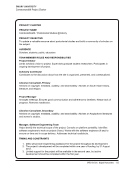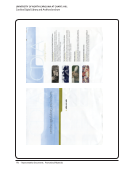20 · Survey Results: Survey Questions and Responses
digitalculturebooks, dedicated to the digital humanities and new media studies. Furthermore, the MPublishing wing
includes several units dedicated to digitization and digital dissemination of humanities material. The infrastructure for
HathiTrust, and much of its administrative staff, is housed at the U-M Library. The Digital Library Publishing Services unit
of library IT has long been a leader in digital archiving. The recent addition of a unit called the Digital Media Commons
(including a 3D lab, 3D printers, Media conversion labs, performances spaces, and a top-tier audio recording studio) to
the library will be increasingly used for digital humanities projects.
Currently there isn’t a lot of digital humanities activity here. It’s *very* ad hoc there have only been a couple of projects
so far. We have a relatively new Digital Initiatives and Open Access department in the libraries, whose staff does have
DH expertise, but we work overwhelmingly on digital library services as opposed to DH services.
Depends on the project and specialties needed.
Developers: 2. Content Lead: 1. Role varies depending on the project.
Digital scholarship/humanities librarians (i.e., digital projects librarians) perform project management throughout the
lifecycle of an initiative. These staff also provide similar services to digital projects in non-humanities disciplines. Subject
librarians (mostly in the past) have helped to develop project ideas and speak to user needs for a set of materials. IT
staff provide technical (hardware and software) support, mostly to the Carolina Digital Library and Archives staff who
then use these tools to assist faculty, but occasionally to faculty directly. Graduate and undergraduate student assistants
provide digitization support, metadata creation support, and writing of contextual material. Instructional services
staff consult on usability, interface design, and issues related to integration of data with web-based tools. Technical
services staff consult on metadata implementation, and create collection-level MARC records for digital projects. Library
communications staff provide public relations support.
Five to six staff on average get involved/collaborate, typically: an archivist or curator (to help select objects and define
scope of support, etc.), IT support staff (to structure the project), head of digital library initiatives, head of special
collections, a metadata librarian (to consult about metadata structure or crosswalking), a student assistant (for scanning
objects).
In my department, staff and students are called on an ad hoc basis to help create digital finding aids that are posted on
lib guides. In my capacity as Humanities Librarian and Subject Specialist I have selected some materials for digitization
for the Digital Libraries of the Caribbean and possible FSU Digital Library Collections. I have asked staff and students to
review microfilm and print holdings to identify potential additions to such collections.
In the number above [16 permanent staff], I am including all members of the Libraries Digital Program staff and the
Preservation and Reformatting staff devoted to digitization projects. If I were to add the staffs of the Center for New
Media in Teaching and Learning and the Center for Digital Research and Scholarship, we could add another 50 staff.
All of these 66 staff support digital projects. Not all of them are humanities projects, but we could certainly count at
least 50 percent of their time as dedicated to such, given the fact that the majority of materials scanned, at least, are
of a historic character. When we speak of individual researchers’ projects at the Digital Humanities Center, the number
of staff involved is usually one (DHC head or graduate assistant), most frequently in a consulting or training role, but
occasionally, where some more advanced technical skills are required, the DHC head may get involved in such areas
as processing of files, markup, or database creation. When tasks are of a larger scale, involving the Libraries Digital
Program, Preservation, CCNMTL, or CDRS, as many as 4 to 5 may be involved, here in a production capacity (even
where materials may ultimately be sent out of house for parts of the process).
It all depends on the project.
It depends on the size of the project. Digital Initiatives Librarian and/or the Digital Projects Librarian plus support staff.
digitalculturebooks, dedicated to the digital humanities and new media studies. Furthermore, the MPublishing wing
includes several units dedicated to digitization and digital dissemination of humanities material. The infrastructure for
HathiTrust, and much of its administrative staff, is housed at the U-M Library. The Digital Library Publishing Services unit
of library IT has long been a leader in digital archiving. The recent addition of a unit called the Digital Media Commons
(including a 3D lab, 3D printers, Media conversion labs, performances spaces, and a top-tier audio recording studio) to
the library will be increasingly used for digital humanities projects.
Currently there isn’t a lot of digital humanities activity here. It’s *very* ad hoc there have only been a couple of projects
so far. We have a relatively new Digital Initiatives and Open Access department in the libraries, whose staff does have
DH expertise, but we work overwhelmingly on digital library services as opposed to DH services.
Depends on the project and specialties needed.
Developers: 2. Content Lead: 1. Role varies depending on the project.
Digital scholarship/humanities librarians (i.e., digital projects librarians) perform project management throughout the
lifecycle of an initiative. These staff also provide similar services to digital projects in non-humanities disciplines. Subject
librarians (mostly in the past) have helped to develop project ideas and speak to user needs for a set of materials. IT
staff provide technical (hardware and software) support, mostly to the Carolina Digital Library and Archives staff who
then use these tools to assist faculty, but occasionally to faculty directly. Graduate and undergraduate student assistants
provide digitization support, metadata creation support, and writing of contextual material. Instructional services
staff consult on usability, interface design, and issues related to integration of data with web-based tools. Technical
services staff consult on metadata implementation, and create collection-level MARC records for digital projects. Library
communications staff provide public relations support.
Five to six staff on average get involved/collaborate, typically: an archivist or curator (to help select objects and define
scope of support, etc.), IT support staff (to structure the project), head of digital library initiatives, head of special
collections, a metadata librarian (to consult about metadata structure or crosswalking), a student assistant (for scanning
objects).
In my department, staff and students are called on an ad hoc basis to help create digital finding aids that are posted on
lib guides. In my capacity as Humanities Librarian and Subject Specialist I have selected some materials for digitization
for the Digital Libraries of the Caribbean and possible FSU Digital Library Collections. I have asked staff and students to
review microfilm and print holdings to identify potential additions to such collections.
In the number above [16 permanent staff], I am including all members of the Libraries Digital Program staff and the
Preservation and Reformatting staff devoted to digitization projects. If I were to add the staffs of the Center for New
Media in Teaching and Learning and the Center for Digital Research and Scholarship, we could add another 50 staff.
All of these 66 staff support digital projects. Not all of them are humanities projects, but we could certainly count at
least 50 percent of their time as dedicated to such, given the fact that the majority of materials scanned, at least, are
of a historic character. When we speak of individual researchers’ projects at the Digital Humanities Center, the number
of staff involved is usually one (DHC head or graduate assistant), most frequently in a consulting or training role, but
occasionally, where some more advanced technical skills are required, the DHC head may get involved in such areas
as processing of files, markup, or database creation. When tasks are of a larger scale, involving the Libraries Digital
Program, Preservation, CCNMTL, or CDRS, as many as 4 to 5 may be involved, here in a production capacity (even
where materials may ultimately be sent out of house for parts of the process).
It all depends on the project.
It depends on the size of the project. Digital Initiatives Librarian and/or the Digital Projects Librarian plus support staff.
































































































































































































